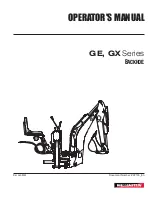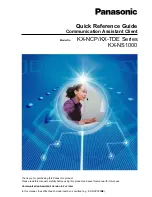
Safety
Safety
8
GE, GX Series
Backhoe
2.3 Why Safety is Important
Three Big Reasons:
•
Accidents Disable and Kill
•
Accidents Cost
•
Accidents Can Be Avoided
The policy of Wallenstein Equipment Inc. is to produce products
that are safe and reliable. However, even when using well-
engineered equipment, there is always an element of risk. To
minimize the risks and promote safety at all times, this section
of the operator’s manual details a number of safety rules that
must always be obeyed.
YOU are responsible for the SAFE operation and maintenance of
your Wallenstein Backhoe. Make sure anyone else who is going
to operate or service the backhoe follows the procedures and
related safety information contained in this manual.
YOU are the key to safety. Good safety practices not only protect
you but also the people around you. Make these practices a
working part of your safety program.
2.4 Safety Rules
•
It is the operator's responsibility to read,
understand and follow ALL safety and
operation instructions in this manual. If
you do not understand any part of this
manual and require assistance, contact
your dealer, distributor, or Wallenstein
Equipment.
•
The operator of this backhoe must be a responsible,
physically able person familiar with machinery and trained
in this machine's operation.
•
Provide instructions to anyone else who is going to operate
the machine. This equipment is dangerous to anyone
unfamiliar with its operation.
•
Review safety related items annually with all personnel who
will be operating or performing maintenance.
•
Make sure all safety signs on the machine are understood
before operating, servicing, adjusting or cleaning. Safety
sign explanations are on page 15. Being unfamiliar with a
machine can lead to injuries.
•
Replace any safety sign or instruction sign that is not
readable or is missing. The location of all safety signs is
indicated on page 14.
•
Never exceed the limitations of the machine. If its ability to
do the job, or to do it safely is in question–
STOP!
•
Have a first-aid kit and fire extinguisher available for use
should the need arise and know how to use them.
•
Do not modify the equipment in any way. Unauthorized
modifications may affect the integrity of the machine
or the ability of the machine to perform as designed.
Modifications can impair safety or function. They can affect
the life of the equipment and void warranty.
•
Make sure the subframe is correctly mounted and all
hardware is torqued to specifications to prevent backhoe
from moving when digging.
•
Never operate the backhoe without the toplink installed.
Make sure it is correctly adjusted to prevent the backhoe
from being pushed upward by digging force. If the backhoe
moves upward the operator can be crushed against the
ROPS, FOPS, or cab. Make sure there is adequate head
room for the operator.
•
Tractor must be equipped with a front loader and ROPS
(Roll Over Protection Structure) or ROPS cab. Always
wear your seat belt when operating the tractor. Serious
injury or even death could result from falling off the tractor
—particularly during a turnover when the operator could
be pinned underneath. Keep a foldable ROPS system in
‘raised–locked’ position at all times.
•
Do not install backhoe if the total machine weight exceeds
the ROPS weight certification.
•
Ensure subframe is firmly attached and all hardware is
torqued to specifications to prevent backhoe from moving
when digging.
2.5 Operating Safety
•
Wear appropriate
Personal Protective Equipment (PPE)
when using this machine. This includes but is not limited
to:
-
Hard hat
-
Hearing Protection
-
Protective shoes with slip resistant soles
-
Protective glasses
•
Always wear hearing protection if the
noise in any area you work in exceeds
80 dB.
- Noise over 85 dB on a long-term
basis can cause severe hearing loss.
- Exposure to noise over 90 dB
over a long-term basis may cause
permanent, total hearing loss.
- Hearing loss from loud noise (from
engines, chainsaws, radios, and
other such sources close to the ear)
is cumulative over a lifetime, without
hope of natural recovery.
•
Know your controls and how to stop engine and attachment
quickly in an emergency.
•
Be aware of overhead hazards: branches, cables, electrical









































